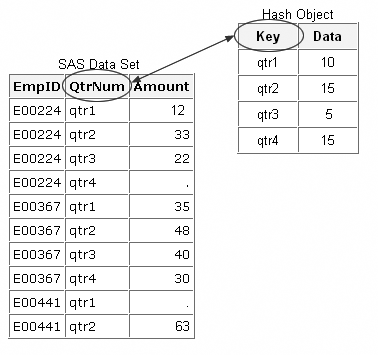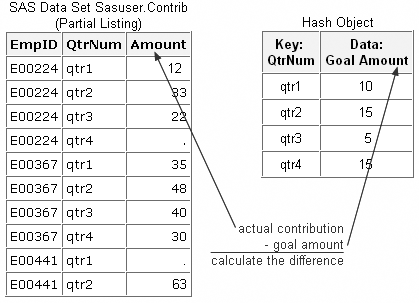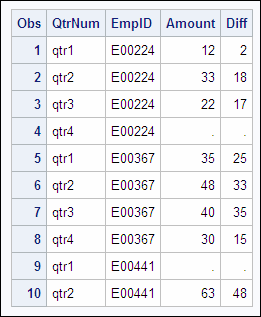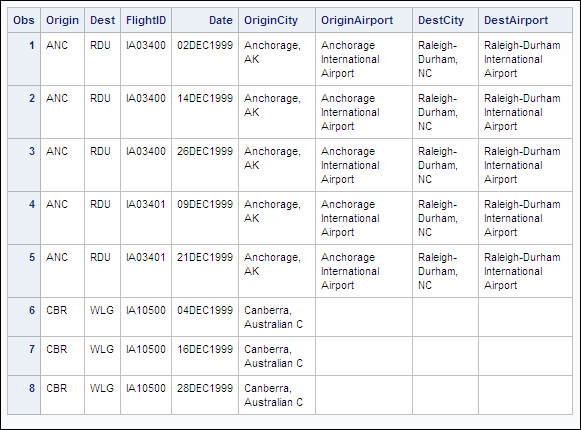Using Hash Objects as Lookup Tables
Overview
Beginning
with SAS 9, the hash object is available for use in a DATA step. The
hash object provides an efficient, convenient mechanism for quick
data storage and retrieval.
Unlike an array, which
uses a series of consecutive integers to address array elements, a
hash object can use any combination of numeric and character values
as addresses. Also unlike arrays, which return only a single value,
hash objects can return multiple values from a given lookup. A hash
object can be loaded from hardcoded values or a SAS data set, is sized
dynamically, and exists for the duration of the DATA step.
The hash object is a
good choice for lookups that use unordered data that can fit into
memory because it provides in-memory storage and retrieval and does
not require the data to be sorted or indexed.
The Structure of a Hash Object
When a lookup depends on character key values, you can
use the hash object. A hash object resembles a table with rows and
columns and contains a key component and a data component.
The key component has
these characteristics:
-
might consist of numeric and character values
-
maps key values to data rows
-
must be unique
-
can be a composite
The data component has
these characteristics:
-
can contain multiple data values per key value
-
can consist of numeric and character values
Example
Suppose you have a data
set named Sasuser.Contrib that lists the quarterly contributions to
a retirement fund. You can use the hash object to calculate the difference
between the actual contribution and the goal amount for each quarter.
The following program
creates a hash object that stores the quarterly goal for employee
contributions to the retirement fund. To calculate the difference
between actual contribution and the goal amount, the program retrieves
the goal amount from the hash object based on the key values.
data work.difference (drop= goalamount);
if _N_ = 1 then do;
declare hash goal( );
goal.definekey("QtrNum");
goal.definedata("GoalAmount");
goal.definedone( );
call missing(goalamount);
goal.add(key:'qtr1', data:10 );
goal.add(key:'qtr2', data:15 );
goal.add(key:'qtr3', data: 5 );
goal.add(key:'qtr4', data:15 );
end;
set sasuser.contrib;
goal.find();
Diff = amount - goalamount;
run;We will see how the
hash object is set up.
DATA Step Component Objects
The hash object is a DATA step component object. Component
objects are data elements that consist of attributes
and methods. Attributes are the properties
that specify the information that is associated with an object. Methods define
the operations that an object can perform.
To use a DATA step component
object in your SAS program, you must first declare and create (instantiate)
the object.
Declaring the Hash Object
You declare a hash object using the DECLARE statement.
|
General form, DECLARE
statement:
DECLARE object-name <(<argument_tag-1:
value-1<,
...argument_tag-n: value-n>>)>;
object
specifies the component
object.
object-name
specifies the name
for the component object.
arg_tag
specifies the information
that is used to create an instance of the component object.
value
specifies the value
for an argument tag. Valid values depend on the component object.
Valid values for object are
as follows:
|
Note: The hash iterator object
retrieves data from the hash object in ascending or descending key
order.
The following DECLARE
statement creates a hash object named Goal.
data work.difference (drop= goalamount);
if _N_ = 1 then do;
declare hash goal();At this point, you have
declared a hash object named Goal.
Note: The DECLARE statement is
an executable statement.
Defining Keys and Data
Remember that the hash object
uses lookup keys to store and retrieve data. The keys and the data
are DATA step variables that you use to initialize the hash object
by using object dot notation method calls.
|
General form, object
dot notation method calls:
object.method(<argument_tag-1:
value-1<,
...argument_tag-n: value-n>>);
object
specifies the name
for the DATA step component object.
method
specifies the name
of the method to invoke.
argument-tag
identifies the arguments
that are passed to the method.
value
specifies the argument
value.
|
A key
component is defined by passing the key variable name to the DEFINEKEY
method. A data component is defined by passing the data variable name
to the DEFINEDATA method. When all key and data components are defined,
the DEFINEDONE method is called. Keys and data can consist of any
number of character or numeric DATA step variables.
The following code initializes
the key variable QtrNum and the data variable GoalAmount.
data work.difference (drop= goalamount);
length goalamount 8;
if _N_ = 1 then do;
declare hash goal();
goal.definekey ("QtrNum");
goal.definedata ("GoalAmount");
goal.definedone();Using the Call Missing Routine
Since
the variable GOALAMOUNT is not in an input data set and does not appear
on the left side of an equal sign in an assignment statement, SAS
issues a note stating that this variable is not initialized.
To avoid receiving these
notes, use the CALL MISSING routine with the key and data variables
as parameters. The CALL MISSING routine assigns a missing value to
the specified character or numeric variables.
data Work.Difference (drop= goalamount);
if _N_ = 1 then do; declare hash goal();
goal.definekey("QtrNum");
goal.definedata("GoalAmount");
goal.definedone();
call missing(goalamount); Loading Key and Data Values
So far, you have declared
and instantiated the hash object, and initialized the hash object's
key and data variables. You are now ready to populate the hash object
using the ADD method. The following code uses the ADD method to load
the key values qtr1, qtr2, qtr3, and qtr4 and the corresponding data
values 10, 15, 5, and 15 into the hash object.
data work.difference (drop= goalamount);
if _N_ = 1 then do;
declare hash goal( );
goal.definekey("QtrNum");
goal.definedata("GoalAmount");
goal.definedone( );
call missing(goalamount);
goal.add(key:'qtr1', data:10 );
goal.add(key:'qtr2', data:15 );
goal.add(key:'qtr3', data: 5 );
goal.add(key:'qtr4', data:15 );
end;Retrieving Matching Data
Use the FIND method to retrieve
matching data from the hash object. The FIND method generates a numeric
return code that indicates whether the key is found in the hash object.
A return code of zero indicates a successful find. A nonzero value
indicates a find failure. If the key is in the hash object, then the
FIND method also sets the data variable to the value of the data item
so that it is available for use after the method call.
data work.difference (drop= goalamount);
if _N_ = 1 then do;
declare hash goal( );
goal.definekey("QtrNum");
goal.definedata("GoalAmount");
goal.definedone( );
call missing(goalamount);
goal.add(key:'qtr1', data:10 );
goal.add(key:'qtr2', data:15 );
goal.add(key:'qtr3', data: 5 );
goal.add(key:'qtr4', data:15 );
end;
set sasuser.contrib;
rc=goal.find();
Diff = amount - goalamount;
run;Hash Object Processing
We will
consider what happens when the program is submitted for execution.
data Work.Difference (drop= goalamount);
if _N_ = 1 then do;
declare hash goal( );
goal.definekey("QtrNum");
goal.definedata("GoalAmount");
goal.definedone( );
call missing(goalamount);
goal.add(key:'qtr1', data:10 );
goal.add(key:'qtr2', data:15 );
goal.add(key:'qtr3', data: 5 );
goal.add(key:'qtr4', data:15 );
end;
set sasuser.contrib;
rc=goal.find();
Diff = amount - goalamount;
run;The program executes
until the SET statement encounters end of file on sasuser.contrib.
PROC PRINT output shows the completed data set.
Creating a Hash Object from a SAS Data Set
Suppose
you need to create a report that shows revenue, expenses, profits,
and airport information. You have two data sets that contain portions
of the required data. The SAS data set Sasuser.Revenue contains flight
revenue data. The SAS data set Sasuser.Acities contains airport data,
including the airport code, location, and name.
|
Origin
|
Dest
|
FlightID
|
Date
|
Rev1st
|
RevBusiness
|
RevEcon
|
|---|---|---|---|---|---|---|
|
ANC
|
RDU
|
IA03400
|
02DEC1999
|
15829
|
28420
|
68688
|
|
ANC
|
RDU
|
IA03400
|
14DEC1999
|
20146
|
26460
|
72981
|
|
ANC
|
RDU
|
IA03400
|
26DEC1999
|
20146
|
23520
|
59625
|
|
ANC
|
RDU
|
IA03401
|
09DEC1999
|
15829
|
22540
|
58671
|
|
ANC
|
RDU
|
IA03401
|
21DEC1999
|
20146
|
22540
|
65826
|
|
City
|
Code
|
Name
|
Country
|
|---|---|---|---|
|
Auckland
|
AKL
|
International
|
New Zealand
|
|
Amsterdam
|
AMS
|
Schiphol
|
Netherlands
|
|
Anchorage, AK
|
ANC
|
Anchorage International
Airport
|
USA
|
|
Stockholm
|
ARN
|
Arlanda
|
Sweden
|
|
Athens (Athinai)
|
ATH
|
Hellinikon International
Airport
|
Greece
|
To create the report,
you can use a hash object to retrieve matching airport data from Sasuser.Acities.
In the following code,
the DECLARE statement creates the Airports hash object and loads it
from Sasuser.Acities.
data work.report;
if _N_=1 then do;
declare hash airports (dataset: "sasuser.acities");
Using a Non-Executing SET Statement
To initialize the attributes of hash variables that
originate from an existing SAS data set, you can use a non-executing
SET statement.
Because the IF condition
is false during execution, the SET statement is compiled but not executed.
The PDV is created with the variables Code, City, and Name from Sasuser.Acities.
data work.report;
if _N_=1 then do;
if 0 then
set sasuser.acities (keep=Code City Name);When you use this technique,
CALL MISSING is not required.
Working with Multiple Data Variables
The
hash object that you worked with earlier in this chapter contains
one key variable and one data variable. In this example, you need
to associate more than one data value with each key.
In the
following code, the DECLARE statement creates the Airports hash object
and loads it from Sasuser.Acities. The DEFINEKEY method call defines
the key to be the value of the variable Code. The DEFINEDATA method
call defines the data to be the values of the variables City and Name.
data work.report;
if 0 then
set sasuser.acities (keep=Code City Name);
if _N_=1 then do;
declare hash airports (dataset: "sasuser.acities")
airports.definekey ("Code");
airports.definedata ("City", "Name");
airports.definedone();
end; |
Key: Code
|
Data: City
|
Data: Name
|
|---|---|---|
|
ANC
|
Anchorage, AK
|
Anchorage International
Airport
|
|
BNA
|
Nashville, TN
|
Nashville International
Airport
|
|
CDG
|
Paris
|
Charles de Gaulle
|
|
LAX
|
Los Angeles, CA
|
Los Angeles International
Airport
|
|
RDU
|
Raleigh-Durham, NC
|
Raleigh-Durham International
Airport
|
Note: To define all data set variables
as data variables for the hash object, use the ALL: “YES”
option. Here is an example:
hashobject.DEFINEDATA
(ALL:“YES”);
Note: The hash object can store
multiple key variables as well as multiple data variables.
Retrieving Multiple Data Values
You can use the FIND
method multiple times in order to retrieve multiple data values. In
the following program, the FIND method retrieves the values of City
and Name from the Airports hash object based on the value of Origin.
data work.report;
if _N_=1 then do;
if 0 then set sasuser.acities (keep=Code City Name);
declare hash airports (dataset: "sasuser.acities");
airports.definekey ("Code");
airports.definedata ("City", "Name");
airports.definedone();
end;
set sasuser.revenue;
rc=airports.find(key:origin);
OriginCity=city;
OriginAirport=name;
rc=airports.find(key:dest);
DestCity=city;
DestAirport=name;
run;PROC PRINT output shows
the completed data set.
proc print data=work.report;
var origin dest flightid date origincity originairport
destcity destairport;
run;Using Return Codes with the FIND Method
Remember
that method calls generate a numeric return code that indicates whether
the method succeeded or failed. A value of
0 indicates
that the method succeeded. A nonzero value indicates that the method
failed.
To store the value of
the return code in a variable, specify the variable name RC at the
beginning of the method call. Here is an example:
rc=hashobject.find (key:keyvalue);The return code variable
can be used in conditional logic to ensure that the FIND method found
a KEY value in the hash object that matches the KEY value from the
PDV.
Example
Error messages are written
to the log when the following program is submitted.
data work.report;
if _N_=1 then do;
if 0 then set sasuser.acities (keep=Code City Name);
declare hash airports (dataset: "sasuser.acities");
airports.definekey ("Code");
airports.definedata ("City", "Name");
airports.definedone();
end;
set sasuser.revenue;
airports.find(key:origin);
OriginCity=city;
OriginAirport=name;
airports.find(key:dest);
DestCity=city;
DestAirport=name;
run;
NOTE: There were 50 observations read from the data set SASUSER.ACITIES.
ERROR: Key not found.
ERROR: Key not found.
ERROR: Key not found.
ERROR: Key not found.
ERROR: Key not found.
ERROR: Key not found.
NOTE: The SAS System stopped processing this step because of errors.
NOTE: There were 142 observations read from the data set SASUSER.REVENUE.
WARNING: The data set WORK.REPORT1 may be incomplete. When this step was
stopped there were 142 observations and 14 variables. |
A closer examination
of the output shows that the data set Work.Report contains errors.
For example, notice that in observations 6 through 8 the value of
both OriginCity and DestCity is
Canberra, Australian
C and the values of OriginAirport and DestAirport
are missing.
The errors occur because
the Airports hash object does not include the key value WLG or a corresponding
Name value for the key value CBR.
Conditional logic can
be added to the program to create blank values if the values loaded
from the input data set, Sasuser.Revenue, cannot be found in the Airports
hash object:
-
If the return code for the FIND method call has a value of
0, indicating that the method succeeded, the values of City and Name are assigned to the appropriate variables (OriginCity and OriginAirport or DestCity and DestAirport). -
If the return code for the FIND method call has a nonzero value, indicating the method failed, the values of City and Name are assigned blank values.
data work.report;
if _N_=1 then do;
if 0 then set sasuser.acities(keep=Code City Name);
declare hash airports (dataset: "sasuser.acities");
airports.definekey ("Code");
airports.definedata ("City", "Name");
airports.definedone();
end;
set sasuser.revenue;
rc=airports.find(key:origin);
if rc=0 then do;
OriginCity=city;
OriginAirport=name;
end;
else do;
OriginCity='';
OriginAirport='';
end;
rc=airports.find(key:dest);
if rc=0 then do;
DestCity=city;
DestAirport=name;
end;
else do;
DestCity='';
DestAirport='';
end;
run;PROC PRINT output shows
the completed data set. Notice that in observations 6 through 8, the
value of DestCity is now blank and no error messages appear in the
log.
proc print data=work.report;
var origin dest flightid date origincity originairport
destcity destairport;
run;..................Content has been hidden....................
You can't read the all page of ebook, please click here login for view all page.






